Photos 4
Delaware site, Bridge plot
Welcome to Tidal Marsh Land, home of the biting flies, smelly black mudholes, and 105� heat indices! I spent the majority of the project chasing birds here and pulled off more trials than in Maryland, although I still don�t know whether I got enough. (Sample size, schmample size.) The only plant these marshes have in common with the Maryland ones is the cattail; otherwise, the environment is completely different.
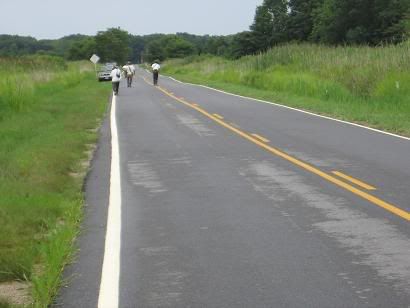
We worked in the marsh on the right side of the photo. Sometimes people driving by would pull up, tell us they always saw us going in there, and ask what we did in there every day. We even got some regulars stopping by to ask about the sparrows.
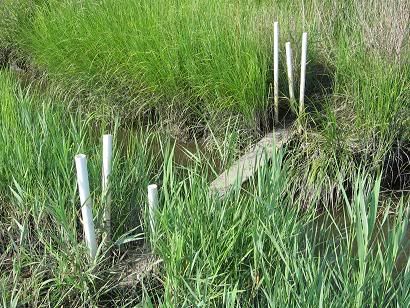
There�s a gut (creek) between the road and the marsh, so early in the season Brian set up planks to cross it.
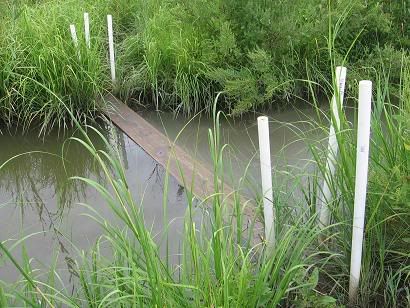
It works nicely until high tide, whereupon it becomes a floating piece of wood. You can still cross it, if you�re okay with not seeing your feet. Fortunately, no one�s fallen in yet.
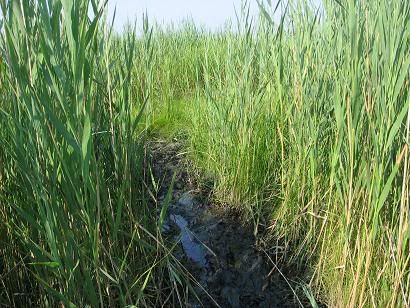
Clearly the vegetation has grown to monstrous heights by mid-July. Also, the path has become less a path than a Slip 'n' Slide.
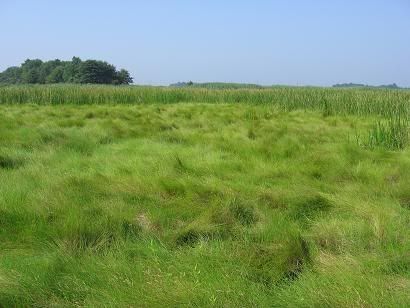
Ah, a lovely expanse of marsh, with grasses waving gently in the breeze! Or so it appears.
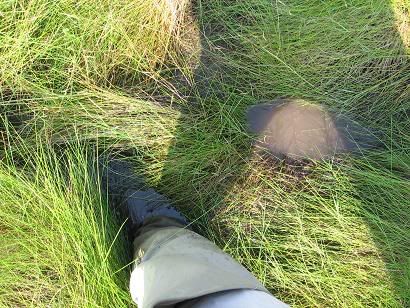
No terra firma here; the ground is really uneven because the cordgrass grows in clumps. By this time of the season, it�s grown so long that it hides all the holes between the clumps and results in ankle-twisting or sinking every few steps.
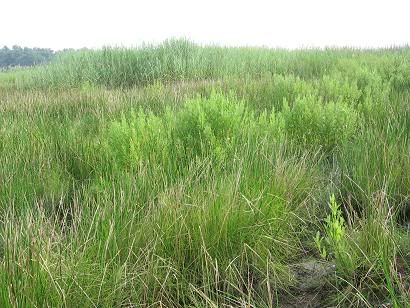
The vegetation grows in patches; some places look relatively homogeneous, while others are thick with a variety of bulrushes, reeds, and shrubs.
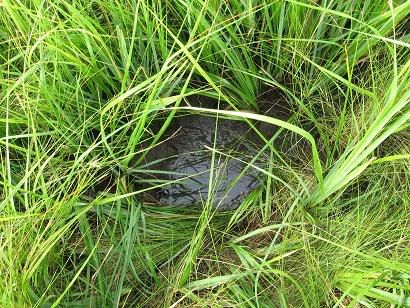
But that doesn�t stop the holes from lurking. (I sank knee-deep into this innocuous one. No joke.)
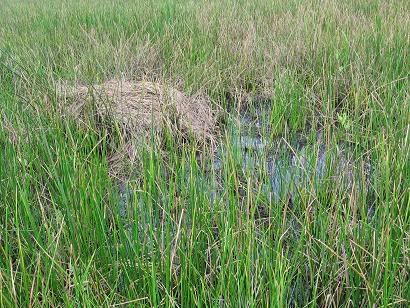
Argh. It�s a muskrat lodge under construction. Note the pools already forming around it, meaning the muskrat has begun its tunneling that inevitably leads to our falling in the water. (Here�s a picture of one. They look like miniature beavers with skinny tails.)
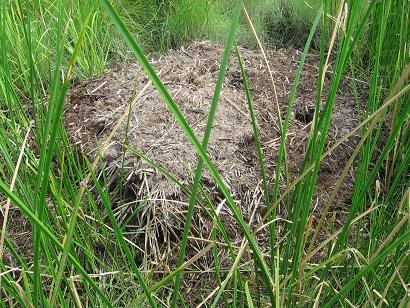
They build them out of bulrushes (thick grass-like plants with triangular stems) and LEAVE THEM THERE. One day the swamp will be taken over by decrepit, abandoned lodges and the ground will collapse from tunnels everywhere.
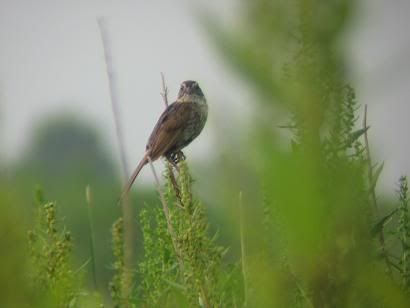
Swamp sparrow pictures! I took them through binoculars, and they are miraculously focused. This bird had a territory in the back of the plot. His test results were dubious; don�t know if I can use them.

He was one of a few birds that switched song types in mid-song, sort of like �tweet, tweet, chirp-chirp-chirp-chirp!� Believe me, it sounds weird.

This is Ben, measuring a nest he just found. He got so good at finding them that he accidentally started labeling nests left from last year.

Josh also located a nest and is labeling it with the blue tape. I sat with him this time and still have no idea how he did it.
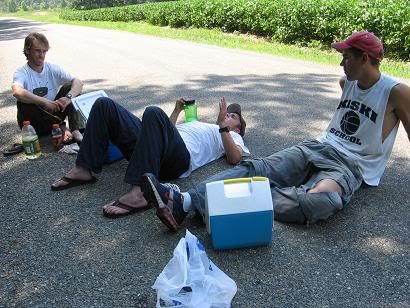
Lunch was on a shady road that had to be ten degrees cooler than in the marsh. That�s Joel, Josh and Ben in typical discourse.

This is a banded sparrow caught in a mistnet. I got to try untangling them on my last day here. I haven�t quite mastered the technique of doing so, and I�m always afraid it�s going to injure itself while I�m holding on to it.
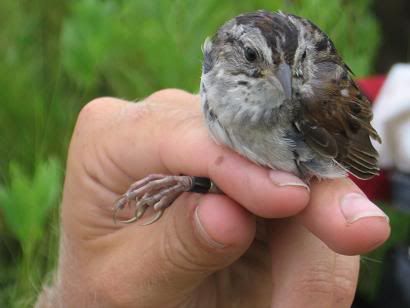
Of course, everyone else was well-practiced in taking birds out. Here�s one looking mildly annoyed in Brian�s hand.
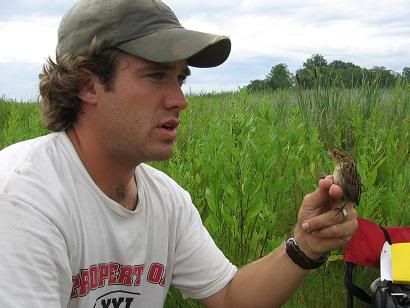
We also caught a female salt marsh sharp-tailed sparrow (that�s Brian holding her). The cool thing is that there are no breeding records of them in Delaware, but this one showed the signs that she might have laid eggs.
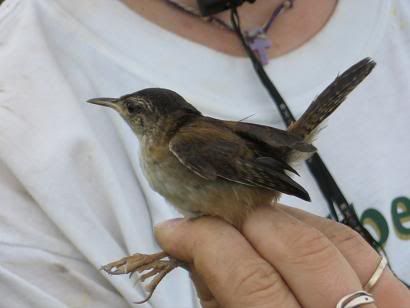
Marsh wrens are small birds common to tidal marshes. They would be totally cute except for their occasional habit of destroying sparrow eggs and killing chicks. Their song is a funny-sounding rattle, and they�re really hyperactive. This one flew back into the net three times after Kate let him go.
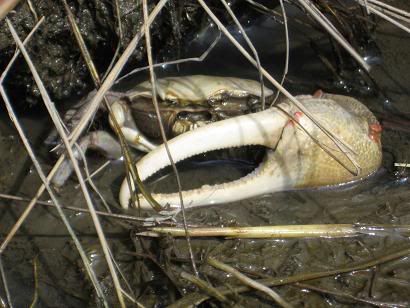
The adult fiddler crabs were dying by the end of the season, but I was lucky enough to find a live one. (It didn�t react when I approached it, though, so I�m not sure about its chances.) They�re about four inches long, and they wave and snap their huge claw in defense before scuttling down a hole and blocking it with their claw.
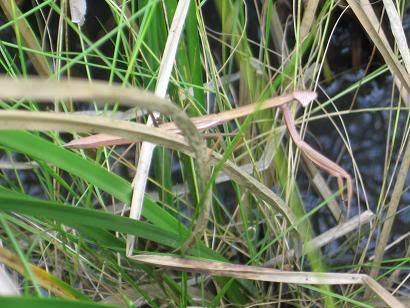
This praying mantis was a totally lucky find; they�re really well camouflaged, and I only saw it because it moved while I was staring in its direction. It was the only live mantis I saw; on two previous occasions I saw one clamped in the beak of a red-winged blackbird as it flew to feed its chicks.
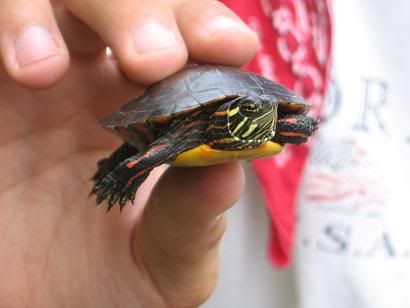
There was a painted turtle crossing the road, and Ben (the turtle expert) got super-excited and spent most of lunch examining it. Despite its tiny size, he said it was three years old. It was the fastest turtle I�ve ever seen; as soon as we set it down, it scuttled into the woods.
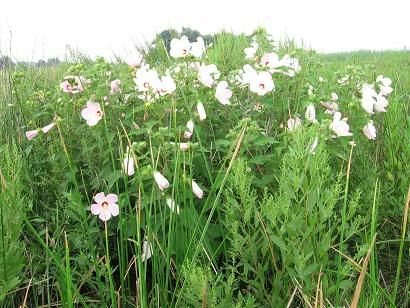
These huge flowers began blooming in late July. They�re called rose mallow and are related to marsh mallows, from whose roots the original marshmallows were made. I got creative and took a bunch of pics from different angles. (For once, my subjects held still for me.)
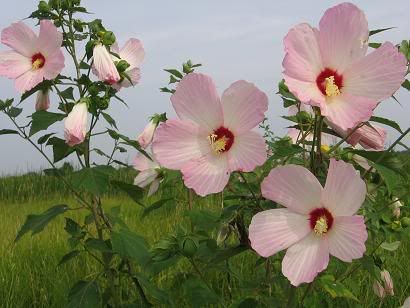

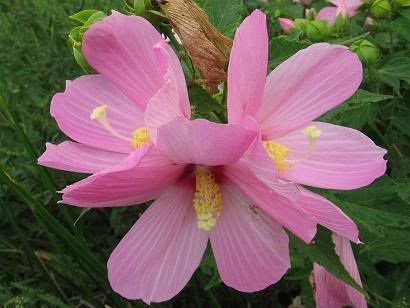

Oh hello, it�s me.
Gate plot photos next!